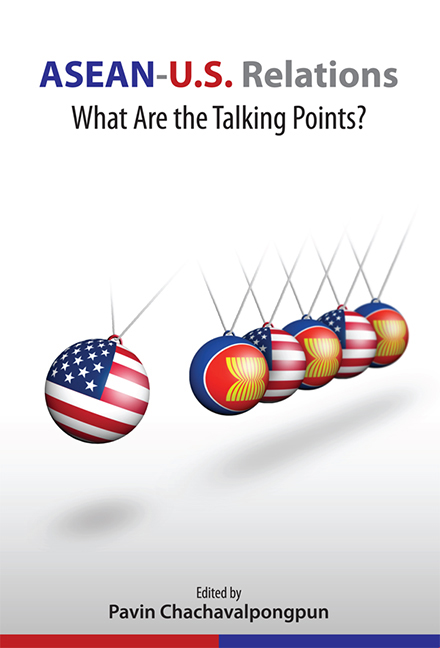Book contents
- Frontmatter
- Contents
- List of Tables and Figures
- Preface
- Contributors
- List of Abbreviations
- OVERVIEW
- 1 U.S. Engagement with ASEAN
- 2 ASEAN-U.S. Relations
- 3 Developments in ASEAN-U.S. Relations
- 4 The United States, Russia to be Part of East Asia Summit
- 5 How Does the United States Play into the East Asia Summit for ASEAN?
- QUINTESSENTIAL ISSUES
- Index
1 - U.S. Engagement with ASEAN
from OVERVIEW
Published online by Cambridge University Press: 21 October 2015
- Frontmatter
- Contents
- List of Tables and Figures
- Preface
- Contributors
- List of Abbreviations
- OVERVIEW
- 1 U.S. Engagement with ASEAN
- 2 ASEAN-U.S. Relations
- 3 Developments in ASEAN-U.S. Relations
- 4 The United States, Russia to be Part of East Asia Summit
- 5 How Does the United States Play into the East Asia Summit for ASEAN?
- QUINTESSENTIAL ISSUES
- Index
Summary
In November 2009 in Singapore, all the leaders of ASEAN met, for the first time in the organization's history, the President of the United States, Barack Obama. That historic meeting was another important milestone in the ASEAN-U.S. relationship.
The objective of this publication and of the workshop on which it is based is to illuminate the facts of those relations and the specific matter of the United States’ engagement with ASEAN and East Asia, for possible use by ASEAN in discussions at the subsequent ASEANU. S. Summit Meeting and at other ASEAN-U.S. policy forums. The topics of discussion cover several elements of this relationship, ranging from the U.S. military presence in the ASEAN region, cooperation on maritime security, and recent U.S. policy towards Myanmar, to progress on economic and technical cooperation.
U.S. ENGAGEMENT WITH ASEAN
Since the ASEAN and American leaders met in 2009, many in Southeast Asia have believed that this was a new beginning in the United States’ re-engagement with ASEAN. In recent years, although bilateral activities were carried out smoothly, some people in ASEAN faulted the United States for inattention to Southeast Asia at the highest leadership levels, noting that Secretary of State Condoleezza Rice's attendance at key meetings was very sporadic and that President George W. Bush was not a frequent visitor to the region. A “presidential presence” in the region was considered to be a necessary complement to diplomatic and trade initiatives.
The United States’ re-engagement with ASEAN would allow Washington to become directly involved in regional institutions. This would also enable the United States to become deeply involved in shaping the agendas of such groups. It would undoubtedly serve America's own interests far better in the longer term than its staying at the periphery. Economically, the United States continues to be a key export market for the ASEAN countries, but its importance has been falling just as China's has been increasing. The United States has also been the leading single-country investor in the region. ASEAN could do more to increase its attractiveness to American corporations by improving its trade and investment policies and practices. A cooperative ASEAN Economic Community (AEC) would create a strong incentive for American corporations to invest in ASEAN nations, which, in turn, would boost overall U.S.-ASEAN economic activity.
- Type
- Chapter
- Information
- ASEAN-U.S. RelationsWhat Are the Talking Points?, pp. 3 - 5Publisher: ISEAS–Yusof Ishak InstitutePrint publication year: 2011



